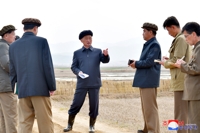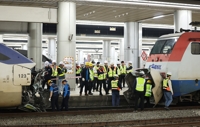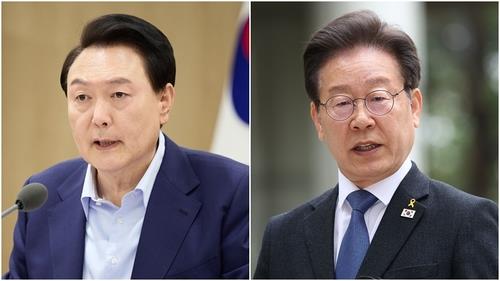(7th LD) N. Korea fires what seems to be SLBM toward East Sea: S. Korea
(ATTN: ADDS telephone talks between S. Korea, U.S. nuclear envoys in paras 20-21)
By Song Sang-ho
SEOUL, Oct. 19 (Yonhap) -- North Korea fired what appears to be a submarine-launched ballistic missile (SLBM) toward the East Sea on Tuesday, South Korea's military said, in yet another setback to Seoul's drive for peace with Pyongyang.
The short-range missile was launched from waters east of Sinpo, a city on the North's east coast, according to the Joint Chiefs of Staff (JCS). The launch was detected at 10:17 a.m., it said.
The missile traveled about 590 kilometers at a top altitude of around 60 km, an informed source said, noting the possibility that the North might have used a submarine as a launch platform this time.
The North previously conducted an SLBM test in 2015 and 2019. The South's military believes that it used a barge rather than a submarine during the past tests.
Officials said that Tuesday's launch came after South Korean and U.S. intelligence authorities had detected signs of a possible weapons test near Sinpo, where the North has been pushing to build a 3,200-ton submarine capable of SLBM operations.
"The intelligence authorities of South Korea and the United States are currently conducting a thorough analysis regarding additional details on the missile," the JCS said in a text message sent to reporters.
The North's latest missile test marks its eighth known projectile launch this year. It previously fired a new hypersonic missile, called the Hwasong-8, on Sept. 28.
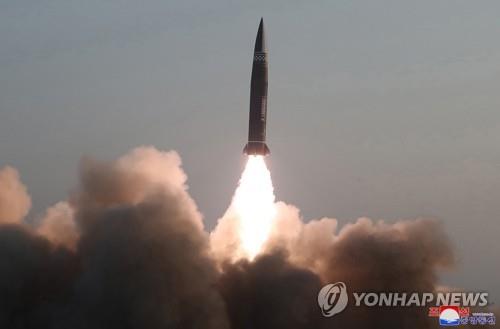
This file photo, released by North Korea's official Korean Central News Agency, shows a missile launch. (For Use Only in the Republic of Korea. No Redistribution) (Yonhap)
The U.S. Indo-Pacific Command condemned the missile launch, calling on the North to refrain from "any further destabilizing acts."
"While we have assessed that this event does not pose an immediate threat to U.S. personnel, territory, or that of our allies, we will continue to monitor the situation," the command said in a statement posted on its website.
"The U.S. commitment to the defense of the ROK and Japan remains ironclad," it added, referring to South Korea's official name, the Republic of Korea.
China called for concerned countries to exert "restraint," saying the situation on the Korean Peninsula stands at a critical period.
"Each relevant country should think from a broad perspective, maintain restraint and make efforts to safeguard peace and stability on the Korean Peninsula," Wang Wenbin, a foreign ministry spokesperson, told a regular press briefing.
North Korea watchers cited a possibility that a new, small-sized SLBM, capable of striking targets in the South or Japan, might have been fired from a 2,000-ton submarine on Tuesday. The North displayed a mini-SLBM at a defense exhibition in Pyongyang last week.
"If you look at the launch site and the missile details, the possibility is that it could be a new-type, small SLBM developed with an intention to attack vulnerable areas in the South, such as the rear and sides," Shin Jong-woo, a senior analyst at the Korea Defense Security Forum, said.
In recent years, Pyongyang has boasted its development of various SLBMs, including the "Pukguksong-4ㅅ" and the "Pukguksong-5ㅅ," which were unveiled during military parades in October last year and January, respectively.
The North has been pushing for the SLBM, which experts say would potentially serve as a key nuclear delivery vehicle designed to keep hostile forces at bay during wartime.
The launch came as the top nuclear envoys of the South, the U.S. and Japan are in Washington to discuss joint efforts to bring the North back to dialogue through humanitarian aid and other incentives.
Pyongyang's continued saber-rattling tempered cautious optimism that has emerged since the reactivation of inter-Korean communication channels earlier this month.
In Washington on Tuesday, Seoul's top nuclear envoy, Noh Kyu-duk, and his U.S. and Japanese counterparts, Sung Kim and Takehiro Funakoshi, plan to meet trilaterally to discuss a joint strategy on the North.
Shortly after the North's presumed test of an SLBM, Noh and Kim held telephone talks and exchanged relevant information, Seoul's foreign ministry said.
They will discuss plans to bring the North back to the negotiating table during the planned trilateral talks, according to the ministry.
On Monday, Noh and Kim met bilaterally and discussed President Moon Jae-in's recent proposal for the declaration of a formal end to the 1950-53 Korean War, which Seoul believes is an effective measure to build confidence with Pyongyang.
The U.S. envoy plans to visit Seoul later this week to further discuss diplomacy toward the North.
sshluck@yna.co.kr
(END)
-
 Overdue debut of Korean abstract art pioneer Yoo Young-kuk at Venice Biennale
Overdue debut of Korean abstract art pioneer Yoo Young-kuk at Venice Biennale -
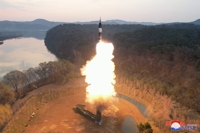 Defense chief says N. Korea's hypersonic missile 'unsuccessful' in last-stage glide flight
Defense chief says N. Korea's hypersonic missile 'unsuccessful' in last-stage glide flight -
 Relax, immerse yourself in scents at Venice Biennale's Korean Pavilion
Relax, immerse yourself in scents at Venice Biennale's Korean Pavilion -
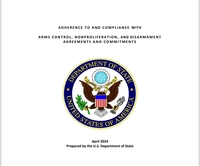 N. Korea has capability to genetically engineer biological military products: U.S. report
N. Korea has capability to genetically engineer biological military products: U.S. report -
 S. Korea marks 30th anniv. of Korean Pavilion at Venice Biennale with contemporary art
S. Korea marks 30th anniv. of Korean Pavilion at Venice Biennale with contemporary art
-
 Overdue debut of Korean abstract art pioneer Yoo Young-kuk at Venice Biennale
Overdue debut of Korean abstract art pioneer Yoo Young-kuk at Venice Biennale -
 Relax, immerse yourself in scents at Venice Biennale's Korean Pavilion
Relax, immerse yourself in scents at Venice Biennale's Korean Pavilion -
 Artist Lee Bae captures ethereal Korean aesthetics at Venice Biennale
Artist Lee Bae captures ethereal Korean aesthetics at Venice Biennale -
 S. Korea marks 30th anniv. of Korean Pavilion at Venice Biennale with contemporary art
S. Korea marks 30th anniv. of Korean Pavilion at Venice Biennale with contemporary art -
 Defense chief says N. Korea's hypersonic missile 'unsuccessful' in last-stage glide flight
Defense chief says N. Korea's hypersonic missile 'unsuccessful' in last-stage glide flight
-
 Gov't likely to accept university chiefs' request to lower med school enrollment quota
Gov't likely to accept university chiefs' request to lower med school enrollment quota -
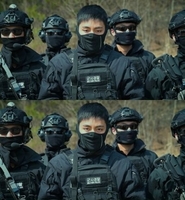 Facebook page unveils photos of BTS member V in counter-terrorism unit gear
Facebook page unveils photos of BTS member V in counter-terrorism unit gear -
 S. Korea not invited to G7 summit meeting this year: sources
S. Korea not invited to G7 summit meeting this year: sources -
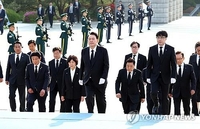 Yoon's approval rating sinks to lowest point since taking office
Yoon's approval rating sinks to lowest point since taking office -
 S. Korea to fully shift to 'endemic' from COVID-19 pandemic starting next month
S. Korea to fully shift to 'endemic' from COVID-19 pandemic starting next month















